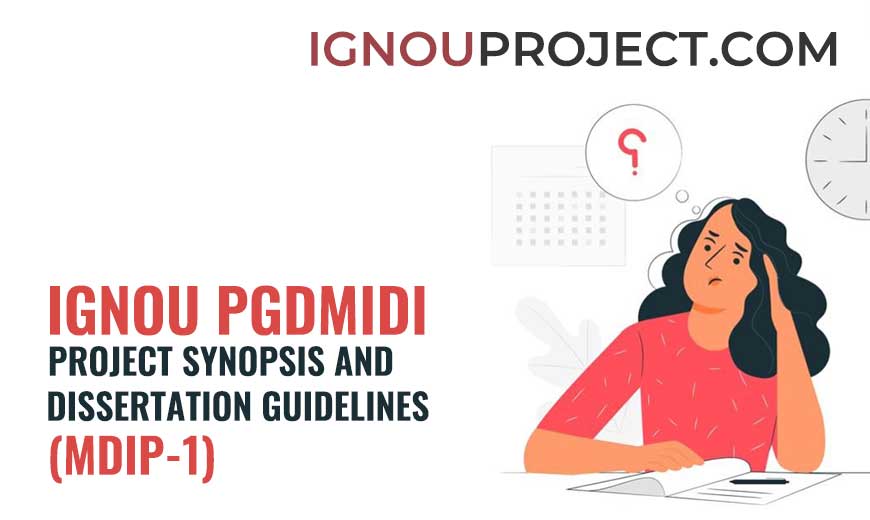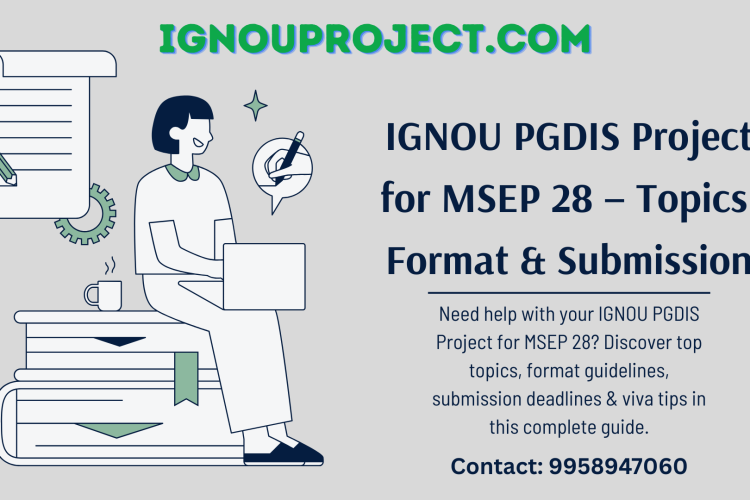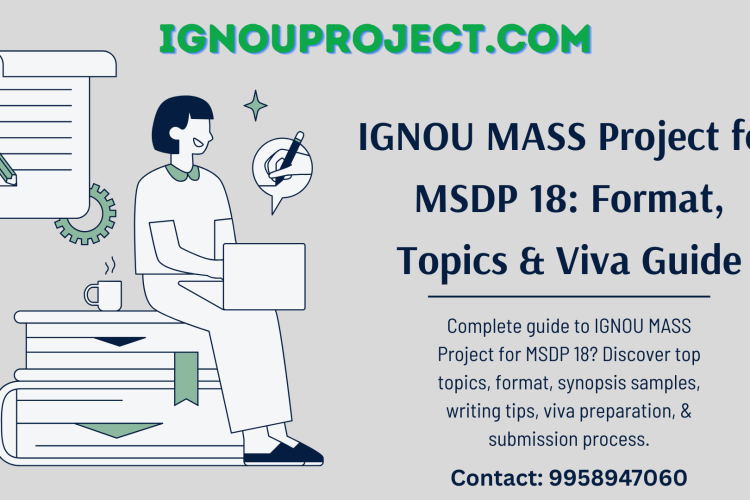
Introduction to the IGNOU PGDMIDI Project
Welcome to our in-depth introduction to the IGNOU PGDMIDI Project (MDIP-1)! As an Indira Gandhi National Open University (IGNOU) student pursuing the Post Graduate Diploma in Migration and Diaspora (PGDMIDI), you will embark on an exciting journey toward academic achievement and professional growth. The IGNOU PGDMIDI Project, which serves as a capstone project to display your knowledge and skills in the field of migration and diaspora, is an important component of this curriculum.
Whatsapp us to get the Personalized (Customized) IGNOU PGDMIDI Project Report and Synopsis
Download PDF Link for IGNOU PGDMIDI Project for MDIP-1
We will go deep into the world of the IGNOU PGDMIDI Project in this post, providing useful insights, recommendations, and guidance to ensure your success. We’ve got you covered, from appreciating the project’s significance to confronting its many stages. So, let’s get started and discover the keys to completing the IGNOU PGDMIDI Project!
An Overview of the IGNOU PGDMIDI Project
Let us first build a clear understanding of the IGNOU PGDMIDI Project. This project allows you to apply the principles, theories, and techniques you gained in your PGDMIDI program to a real-world business environment. It acts as a link between academics and industry, allowing you to demonstrate your abilities to assess, strategize, and implement international business solutions.
The IGNOU PGDMIDI Project’s Importance
Taking on the PGDMIDI Project is critical for a number of reasons. For starters, it allows you to obtain hands-on experience dealing with real-world business difficulties, giving you a competitive advantage in the employment market. Furthermore, the project allows you to exhibit to potential employers your problem-solving abilities, research acumen, and managerial competence.
Furthermore, the PGDMIDI Project demonstrates your capacity to work independently, manage time effectively, and produce high-quality outputs. The project’s successful completion will not only benefit your academic development but will also boost your professional credibility and open doors to interesting job options in international business management.
FAQs related to the IGNOU PGDMIDI Project Synopsis and Dissertation (MDIP-1)
Let us now answer some frequently asked questions concerning the IGNOU PGDMIDI Project:
Q: When is the deadline for submitting the PGDMIDI project?
A: Your IGNOU study center will usually notify you of the deadline for submitting your PGDMIDI project. It is critical to meet the deadline in order to avoid penalties or delays in graduation.
Q: May I select any topic for my PGDMIDI project?
A: While you have the freedom to choose a topic for your project, it is best if it is related to international business management. It should be relevant to the program’s objectives and demonstrate your grasp of essential subjects.
Q: What should the duration of the PGDMIDI project be?
A: The project report should ideally be between 80 and 100 pages in length, excluding appendices. The exact length, however, will depend on your topic, study area, and institution rules.
Q: Can I get advice from my professors or industry experts during the project?
A: Yes, obtaining advice from your academics or industry professionals is strongly advised. They can offer useful insights, research methodology, and criticism to help you improve the quality of your project.
Q: Is primary research required for the PGDMIDI Project?
A: While primary research is not required, it is advised that it be done whenever possible. Primary research gives your project depth and authenticity by demonstrating your ability to gather and analyze real-world data.
Q: What are the PGDMIDI Project’s evaluation criteria?
The project report is assessed using a number of criteria, including research technique, data analysis, relevance, coherence, presentation, and conformity to guidelines. To improve your chances of scoring well, familiarize yourself with the evaluation criteria.
Processes involved in finishing the IGNOU PGDMIDI Project effectively
Stage 1: Choosing a Project Topic
Choosing the correct project topic is critical since it serves as the foundation for the rest of your project. Here are some pointers to help you make an informed choice:
- Examine Your Interests and Strengths: Choose a topic that corresponds to your interests, strengths, and professional goals. It will keep you motivated throughout the process and help you to properly exhibit your abilities.
- Current Trends: Stay up-to-date on the most recent innovations and trends in international business management. Investigate developing areas, difficulties, and possibilities to identify a relevant and meaningful issue.
- Consult professors and industry professionals. Seek advice from your professors or industry professionals. Their perspectives can assist you in narrowing down your alternatives, validating your ideas, and providing a new perspective on potential research areas.
Remember that selecting the proper topic will not only make your project more fun, but it will also boost your chances of making an important contribution to the field of international business management.
Stage 2: Project Proposal Creation
After you’ve decided on a topic, the next step is to create a well-structured project proposal. This proposal serves as a roadmap for your complete project and assists you in obtaining faculty approval.
- The Project Proposal Structure
- A typical project proposal includes the sections listed below:
- Introduce the project briefly, emphasizing its significance and relevance in the context of international business management.
- Research Objectives
- Clearly define the goals you hope to attain with your project. These goals must be specific, measurable, attainable, relevant, and time-bound (SMART).
- Conduct an in-depth review of existing literature relevant to your topic. Identify any gaps, controversies, or areas that need more investigation. To provide a solid theoretical foundation for your proposal, cite relevant papers, theories, and frameworks.
- Research Methodology: Describe the research methods and strategies that you intend to use. Provide a rationale for your chosen approach, whether it be primary data collection, secondary research, or a combination of the two.
- Data Analysis Plan: Describe the tools and strategies you will employ to examine the obtained data. This section should demonstrate your knowledge of statistical analytic techniques, software programs, and data interpretation.
- Expected results: Anticipate and articulate your project’s likely results. Describe how your findings can add to the corpus of knowledge in international business management.
- Timeline and Resources: Create a realistic project completion timeline, allotting enough time for each stage. Also, include the resources you will need, such as data sources, software, and equipment.
Creating a thorough project proposal ensures that you have a clear path for your project and that you receive relevant input from your faculty before moving on to the execution stage.
Stage 3: Project Implementation and Data Collection
Once your project proposal has been approved, it’s time to roll up your sleeves and get to work on the execution. This step entails gathering relevant data, interpreting it, and developing useful conclusions. Here are some important factors to consider for successful project implementation:
- Data Collection Methods: Select acceptable data collection methods based on your study objectives and available resources. Surveys, interviews, observations, or evaluating existing datasets may be used.
- Maintain Ethical Standards: Make certain that your data collection procedures are ethical. Maintain the integrity of your research process by obtaining informed consent from participants and protecting their privacy and confidentiality.
- Data Analysis: Analyze the collected data using relevant statistical tools and procedures. For data interpretation and visualization, use software applications such as SPSS, Excel, or specialist programs.
- Interpretation and Insights: Analyze and analyze the outcomes of your data study. Relate the findings to your study objectives, review of literature, and theoretical frameworks. Identify patterns, trends, and consequences that contribute to the overall significance of your project.
Remember that thorough data collection and analysis are essential components of a successful PGDMIDI project. Pay close attention to detail and assure the research’s integrity and validity.
Stage 4: Report Writing and Presentation
The PGDMIDI Project concludes with you presenting your results and insights in a well-structured project report. Your report should demonstrate the breadth of your study, the clarity of your thoughts, and your ability to communicate effectively. Here are some pointers for writing an impressive project report:
- Structure and Formatting: Use the IGNOU-provided format and guidelines. Make sure that the headers, subheadings, font size, spacing, and referencing style are all consistent.
- Introduction: Write a brief introduction outlining the project’s goal, objectives, and scope. Establish the background for your study and clearly describe the research question(s).
- Literature Review: Provide a thorough review of relevant literature. To complement your research and give a theoretical foundation for your analysis, synthesize current ideas, studies, and frameworks.
- Describe the research strategy, data collection methods, and analysis procedures used. Justify your decisions and rectify any shortcomings or potential biases in your approach.
- Data Analysis and Findings: Present the results of your data analysis in a logical and structured manner. To improve clarity and comprehension, use tables, graphs, and visual representations. Interpret the findings and connect them to your research objectives.
- Discuss the significance of your findings in the context of international business management. Connect your findings to current literature and theoretical frameworks. Highlight any shortcomings, propose future research directions, and conclude with a concise review of your project’s significant contributions.
Remember to edit your report thoroughly, looking for grammatical flaws and maintaining a consistent writing style. A project report that is well-written and presented demonstrates your expertise and dedication to academic excellence.
Finally, welcome to the IGNOU PGDMIDI Project Journey.
Congratulations on finishing our in-depth guide to the IGNOU PGDMIDI Project! Throughout this post, we have discussed the relevance of the project, answered frequently asked questions, and provided helpful hints at each stage of its completion.
The IGNOU PGDMIDI Project is more than just a prerequisite for your degree; it is an opportunity to demonstrate your knowledge, talents, and passion for international business management. Accept this trip, take advantage of the tools provided, seek help when necessary, and make the most of this platform to flourish in your academic and professional aspirations.
Now that you’ve armed yourself with the knowledge and tactics offered in this tutorial, it’s time to start on your own IGNOU PGDMIDI Project adventure. Remember that success is defined not only by the destination but also by the enjoyment of the journey!
Ready to get your IGNOU PGDMIDI Project Report and Synopsis Sample PDF for MDIP-1?
- Call us or WhatsApp us at: 9958947060, 9354637830
- Visit: IGNOUPROJECT.COM

